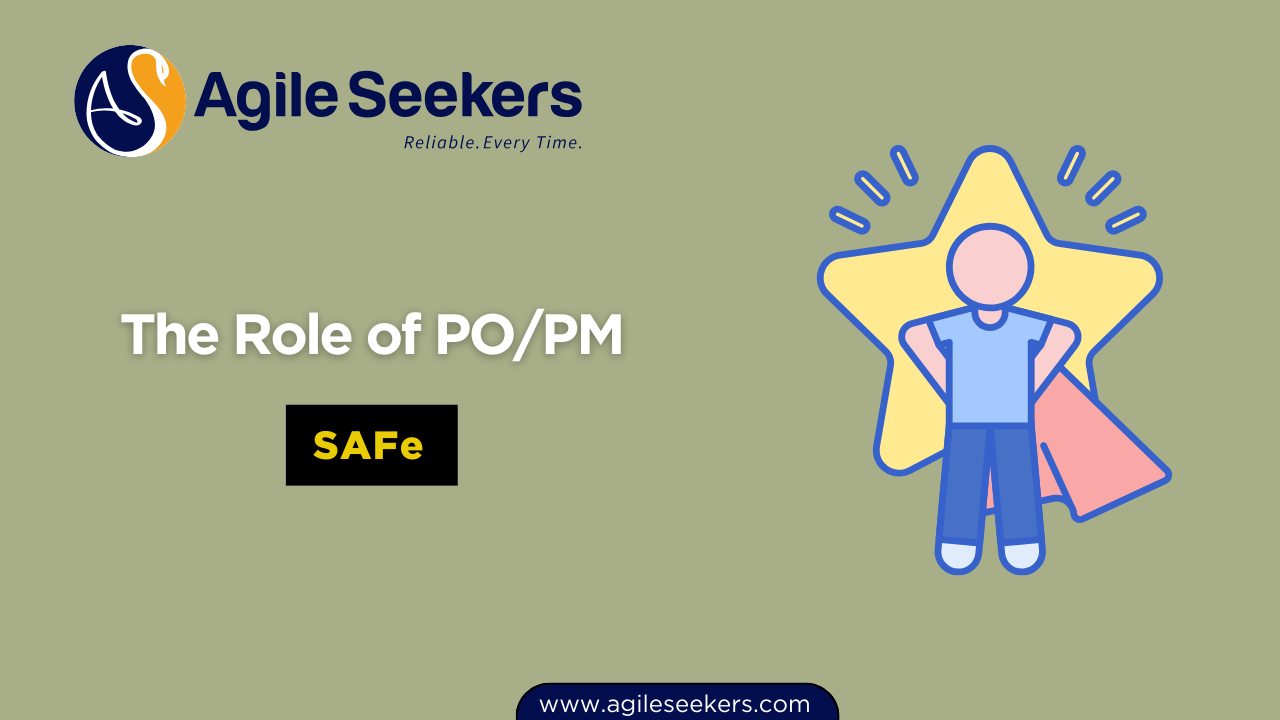The Role of POPM in SAFe

Agile at scale doesn’t work on autopilot. It demands alignment, clarity, and execution at every level. That’s where the Product Owner/Product Manager (POPM) role comes into play in the Scaled Agile Framework (SAFe).
The role of POPMs in SAFe isn’t about writing user stories in isolation or checking boxes. It’s about connecting the dots between business vision and team execution—and making sure that what gets delivered actually matters.
More Than a Middleman: The POPM as a Strategic Driver
In SAFe, Product Managers and Product Owners work as a unit—but they don’t do the same job.
- Product Managers focus on the bigger picture. They define features, prioritize what delivers the most value, and guide multiple Agile teams in the right direction.
- Product Owners stay embedded with the teams. They work day-to-day to turn features into actionable stories, answer questions, validate progress, and keep the team aligned with customer and business goals.
Together, they keep the Agile Release Train (ART) delivering value that supports strategy—not just speed.
Turning Business Vision Into Action
Business leaders define strategic goals, but someone needs to translate those goals into deliverable outcomes. POPMs are that bridge.
Here’s what they actually do:
- Break down big ideas into concrete features and stories.
- Ensure teams don’t lose sight of customer needs.
- Reprioritize constantly to keep pace with change.
- Protect the backlog from bloat and noise.
If strategy doesn’t show up in the backlog, it won’t show up in the product. POPMs make sure it does.
Customer-Centric at the Core
Every decision made by a POPM in SAFe is grounded in one thing: delivering value to the customer.
POPMs don’t just collect requirements. They:
- Spend time with users.
- Analyze feedback.
- Validate assumptions through data and real conversations.
- Use tools like personas and journey maps to guide development.
This relentless focus on customer outcomes is a core part of the SAFe POPM Certification curriculum. And it’s what separates good product development from great product leadership.
SAFe’s Cadence Depends on Strong POPMs
Let’s talk delivery rhythm. SAFe operates on Program Increments (PIs), with a clear cadence and tight collaboration between teams. POPMs are critical in every step of this process.
During PI Planning:
- Product Managers present the vision and define features.
- Product Owners work with teams to create plans that support that vision, with clear objectives and dependencies.
During Execution:
- POPMs track progress, adjust priorities, and make sure the work stays aligned with goals.
- They handle stakeholder feedback and course-correct fast when market needs shift.
During Inspect and Adapt:
- POPMs help teams reflect, measure, and improve—not just build and ship.
Without that hands-on guidance, ARTs lose focus. With strong POPMs, they stay locked on delivering outcomes.
Key Responsibilities—No Buzzwords, Just Reality
| What They Do | Why It Matters |
|---|---|
| Prioritize Backlogs | Teams work on what matters most, not what’s loudest |
| Define Acceptance Criteria | No ambiguity = less rework and fewer surprises |
| Engage with Stakeholders | Keeps expectations real and feedback timely |
| Break Down Work | Teams don’t waste cycles figuring out what needs to be built |
| Align with Business Goals | Delivery is tied to strategy—not just tech for tech’s sake |
POPMs Don’t Just Support Delivery—They Shape It
POPMs are hands-on in every feature that ships. They decide:
- What gets built next
- Why it matters
- When it goes out
- How success is measured
In a SAFe enterprise, that kind of decision-making power has massive impact. It’s how business outcomes get built into product roadmaps, sprint by sprint.
That’s also why the SAFe Product Owner/Manager certification is more than a credential—it’s a signal that someone can think strategically and execute tactically. It’s not a theory-based program. It’s hands-on, real-world training for real-world delivery challenges.
Real Example: POPMs in the Driver’s Seat
Let’s say a global retailer wants to improve its mobile shopping experience. Here’s how POPMs make that happen:
- Product Managers define the top-level features: smarter search, one-click checkout, better product recommendations.
- Product Owners work with teams to break those down into stories: redesigning the UI, integrating new APIs, optimizing performance.
- They both work together to keep delivery aligned with customer feedback, prioritize based on business impact, and adjust the plan as data rolls in.
By the end of the PI, the result isn’t just code—it’s a measurable lift in customer engagement and sales. Strategy. Executed.
Why Organizations Need Trained POPMs
Companies waste money when vision doesn’t match execution. That gap costs time, budget, and customer trust.
Training POPMs properly closes that gap.
The SAFe POPM training equips professionals with the skills to:
- Own backlogs at scale
- Navigate complexity across multiple teams
- Use Lean thinking to prioritize with impact
- Align every sprint with business value
And for those focusing on the team-level backlog, the SAFe Product Owner certification is the right place to start.
Bottom Line: Strategy is Useless Without Execution
It’s easy to talk about innovation, value streams, and customer obsession. But unless those ideas make their way into working software, they don’t matter.
The role of POPMs in SAFe is to make sure they do.
They’re not note-takers or messengers. They’re decision-makers, prioritizers, and translators of business value into working product. Every successful Agile Release Train has strong POPMs behind it.
If you want to build products that matter—on time, on budget, and aligned with strategy—you need skilled POPMs at the helm.
And if you're looking to become one, the SAFe Product Owner/Product Manager Certification is your launchpad.




















